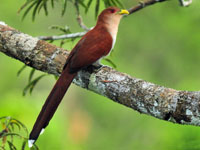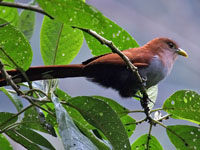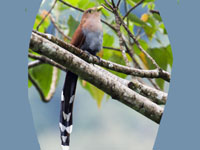* Coccyzinae – New World Cuckoos
* Neomorphinae – New World Ground Cuckoos
* Crotophaginae – Anis
* Cuculinae – Old World Cuckoos
* Phaenicophaeinae – Malkohas and Couas
* Centropodinae – Coucals
This article is about the cuckoo subfamily Coccyzinae whose species are restricted to the Americas. Its three genera are: Coccycua, Coccyzus, and Piaya.
Unlike the ground cuckoos, the members of the Coccyzinae subfamily do much of their foraging in trees and shrubs. Almost all the species of this cuckoo subfamily are not brood parasitic. That is, they lay their eggs in their own nests and raise their chicks. The two exceptions are the black-billed cuckoo (Coccyzus erythropthalmus) and the yellow-billed cuckoo (Coccyzus americanus). And those two species do raise their own young most of the time.
The three species of genus Coccycua are found in the tropical Americas. They are not brood parasites. They are relatively small, have short tails, and do not migrate.They mainly eat insects.
Genus Coccyzus with its 13 species makes up the largest part of this American subfamily of cuckoos. Coccyzus cuckoos feed on large insects such as caterpillars, cicadas, and wasps. Many also feed on lizards. Cuckoos can consume hairy caterpillars because of their ability to shed their abdominal lining and get rid of the hairs via a pellet. They have long wings and are strong fliers. Many species have black under-tails with broad white tips to the feathers which are striking because of the graduated tail.
The two cuckoos of genus Playa are relatively large arboreal cuckoos with very long tails. They mainly eat insects including caterpillars and grasshopers.
The cuckoo family Cuculidae
The cuckoo family Cuculidae is the only family of the order Cuculiformes. The family is represented on all continents except Antarctica. Most species reside in tropical or subtropical environments. Those in temperate locations migrate to avoid cool or cold winters. In addition to cuckoos, the family Cuculidae also includes the roadrunners, koels, malkohas, couas, coucals and anis. The coucals and anis are sometimes separated as distinct families. The
cuckoos are generally medium sized slender birds. The majority are of the cuculidae family are arboreal, with a sizeable minority that is terrestrial.
Cuckoos are medium sized birds that range in size from 15-63 cm. There is generally little sexual dimorphism in size, but where it exists, it can be either
the male or the female that is larger, depending on the genera. There are two basic body forms, arboreal species which are slender and terrestrial species which are more heavy set and have stronger legs. Almost
all species have long tails which are used for steering in terrestrial species and as a rudder during flight in the arboreal species.
Many species are brood parasites, laying their eggs in the nests of other species, but
the majority of species raise their own young. The brood parasitic birds usually only parasitize a single host species or a small group of closely related host species. They tend to remove a host egg when they lay one of their own in a nest. This both prevents the host species from realizing their nest has been parasitized and reduces food competition for the parasitic nestling once it hatches. Some brood parasites will eliminate all their nest-mates shortly after hatching. If the host removes a parasitic egg or chick, the adult parasitic birds may retaliate by destroying the nest.
There has been an evolutionary arms race between the cuckoos that leave their eggs in other nests, and the hosts that get these unwanted presents. The cuckoos have evolved to be able to lay their eggs faster than most other species and the eggs need less incubation time before hatching. These eggs often resemble the host eggs to prevent detection of an invader egg. The drongo-cuckoos resemble their host. Some hosts have evolve to be social so the colony can be on the lookout for an invader trying to deposit an egg. Others have more than one brood of chicks per year so there will be replacements for any losses due to cuckoos.
Cuckoos feed on insects, small animals, seeds, and fruit. For many cuckoo species, caterpillars are their favorite food; even hairy caterpillars that are avoided by most other birds. Cuckoos can consume hairy caterpillars because of their ability to shed their abdominal lining and get rid of the hairs via a pellet. Another favorite food of many cuckoos are grasshoppers. We may find it repugnant that some cuckooos are brood parasitic and they or their offspring even kill the host's chicks, but on the plus side cuckoos help prevent plagues of caterpillars and grasshoppers!
Almost all cuckoos are shy which can make them a challenge to observe and photograph. Consistent with this behavior, they are not colonial breeders. These traits may be have their roots in their brood parasitic behavior. Stealth is a good characteristic if you want to sneak an egg into a host's nest.
Cuckoo family members are zygodactyl: they have the 2 inner toes facing forward and 2 two outer toes facing to the rear.
Genus Coccycua
The three species of this genus are found in the tropical Americas. They are not brood parasites.
Cuckoo,_Ash-colored Coccycua cinerea
Range: South America.
Habitat: Subtropical or tropical forest, bushy areas.
Diet: Insects including their larvae.
Conservation status: Least concern

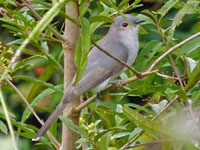
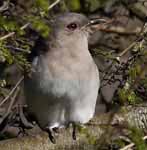
Cuckoo,_Dwarf Coccycua pumila
Range: Panama, Colombia, Venezuela, northern Brazil.
Habitat: Subtropical or tropical forest (even if degraded due to logging).
Diet: Insects including caterpillars. Hunts in trees, scrubs, on ground.
Conservation status: Least concern

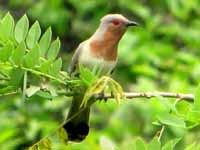
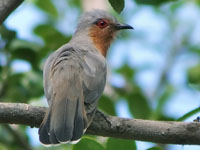
Cuckoo,_Little Coccycua minuta
Range: Panama, South America.
Habitat: Mangrove swamps, and scrubby woodland near water.
Diet: Insects, arachnids, crustaceans.
Conservation status: Least concern


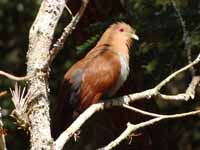

Genus Coccyzus
These cuckoos all build their own nests. However, the yellow-billed and black-billed will occasionally lay eggs in the nest of other species. These two species are also the only two of the species that appear in North America. The other 5 species are restricted to Central and South America.
Cuckoo,_Bay-breasted Coccyzus rufigularis
Range: Dominican Republic on Hispaniola in Caribbean.
Habitat: Under 900 meters (3000 ft) in moist or dry forests.
Diet: Insects including caterpillars and grasshoppers; lizards. Also mice, beetles.
Conservation status: The bay-bay-created cuckoo is listed as endangered because their numbers are declining and their range relatively small.


Cuckoo,_Black-billed Coccyzus erythropthalmus
It is similar to the yellow-billed cuckoo which has a black bill above and yellow below. The black-billed cuckoo bill is all black. Also, the yellow-billed has more white on the underside of its tail than the black-billed.
Range: The Americas.
Habitat: They forage and nest in trees and shrubs.
Diet: Insects, especially caterpillars and cicada. Also eggs, berries, snails.
Conservation status: Least concern
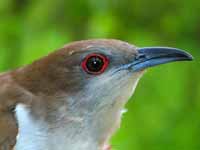
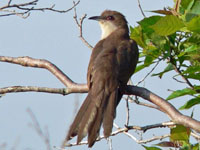
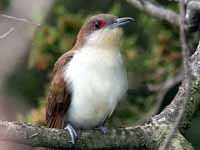

Cuckoo,_Chestnut-bellied Coccyzus pluvialis
Range: Jamaica.
Habitat: Forests and degraded forests.
Diet: Insects including caterpillars, lizards. Also mice, small birds, eggs.
Conservation status: The status is listed as “Least concern”, but it is not a well known species and restricted toJamaica so its health as a species bears watching.
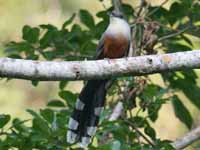
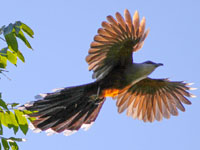
Cuckoo,_Cocos Coccyzus ferrugineus
Range: Island of Cocos off Costa Rica.
Habitat: Mainly forest; also scrub land.
Diet: Insects, especially spiders.
Conservation status: It is threatened by habitat loss.

Cuckoo,_Dark-billed Coccyzus melacoryphus
Range: South America.
Habitat: Wide range of habits allowing it to be widespread.
Diet: Insects, especially caterpillars, grasshoppers, ants.
Conservation status: Least concern
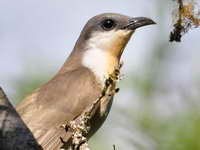
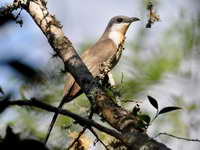

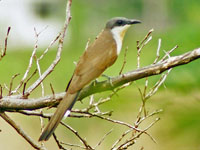
Cuckoo,_Great_Lizard- Coccyzus merlini
Range: Bahamas, Cuba.
Habitat: Forest and scrub.
Diet: Insect, lizards, frogs, snakes.
Conservation status: Least concern
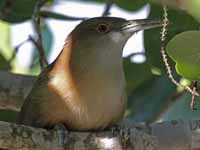
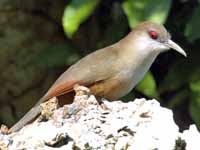
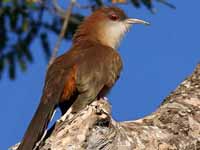
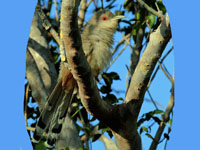
Cuckoo,_grey-capped Coccyzus lansbergi
Range: Northern South America.
Habitat: Varied from forests to bushes.
Diet: Insects, especially caterpillars.
Conservation status: Least concern.
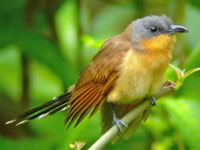
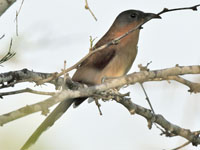
Cuckoo,_Hispaniolan Lizard- Coccyzus longirostris
Range: Hispaniola (Haiti and Dominican Republic).
Habitat: Forests and bushes.
Diet: Insects, especially caterpillars and grasshoppers. Also lizards.
Conservation status: Least concern
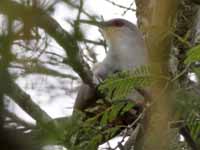

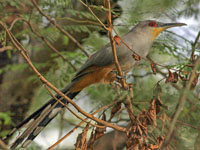
Cuckoo,_Jamaican Lizard Coccyzus vetula
Range: Jamaica.
Habitat: It forages in trees searching for lizards.
Diet: Mainly lizards.
Conservation status: Least concern
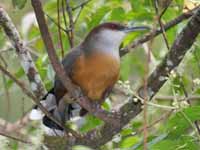
Cuckoo,_Mangrove Coccyzus minor
Range: south Florida to north Brazil.
Habitat: Mangrove swamps and higher ground (hammocks) accompanying them.
Diet: Insects, especially caterpillars and grasshoppers. Also snails, spiders, small lizards, fruit.
Conservation status: Least concern

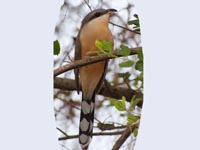
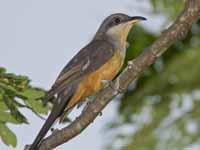
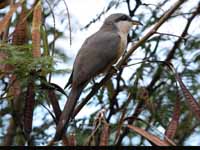
Cuckoo,_Pearly-breasted Coccyzus euleri
Range: South America.
Habitat: Forest and scrub lands.
Diet: Insects, especially caterpillars.
Conservation status: Least concern
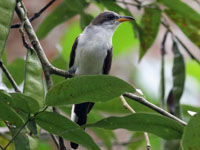
Cuckoo,_Puerto Rican Lizard- Coccyzus vieilloti
Range: Puerto Rico.
Habitat: Forests and coffee plantations.
Diet: Mainly lizards; also insects and spiders.
Conservation status: Least concern
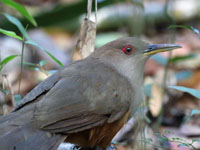

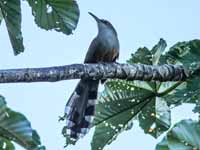
Cuckoo,_Yellow-billed Coccyzus americanus
Range: The Americas.
Habitat: They forage and nest in trees and shrubs.
Diet: Insects especially caterpillars and cicada. Also lizards.
Similar to:
* Black-billed cuckoo. Yellow-billed cuckoo has a black bill above and yellow below; Black-billed Cuckoo bill is all black. Yellow-billed sometimes has a visible yellow eye-ring; Black-billed eye-ring is red. Yellow-billed has more white on the underside of its tail than the black-billed.
* Pearly-breasted Cuckoo. Yellow-billed cuckoo has chestnut wings.
* Mangrove Cuckoo. Mangrove cuckoo is best differentiated from yellow-billed cuckoo by its black facial mask and buffy underparts. Both species have black bill above and yellow below. Both have yellow eye-ring.
Conservation status: Least concern
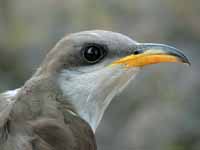
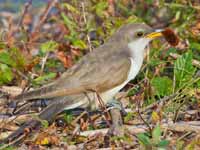
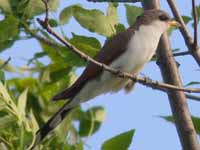


Genus Piaya
These species have relatively slight bodies and long tails. They are not brood parasitic, that is, they raise their own young.
Cuckoo,_Black-bellied Piaya melanogaster
Range: Amazon region of South America.
Habitat: Tropical forest and scrubs in nearby areas. Not found at the coast.
Diet: Insects including caterpillars and grasshopers. Also spiders and crustaceans.
Conservation status: Least concern


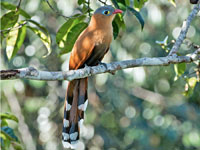
Cuckoo,_Squirrel Piaya cayana Found: Central and South America
Range: Central and South America.
Habitat: Spends most of its time in trees.
Diet: Insects including caterpillars and grasshoppers; also spiders.
Conservation status: Least concern.
